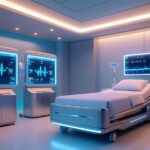The healthcare industry is undergoing a significant transformation, with touchless medical monitoring emerging as a game-changer. This innovative technology leverages artificial intelligence (AI), remote sensors, and advanced algorithms to track patients’ health without physical contact. As the demand for more efficient, safe, and accurate healthcare solutions grows, touchless monitoring is becoming an essential tool for both patients and medical professionals.
What Is Touchless Medical Monitoring?
Touchless medical monitoring refers to the use of non-invasive technologies to track vital signs, detect health abnormalities, and monitor chronic conditions. These systems utilize sensors, computer vision, and AI-powered algorithms to measure metrics like heart rate, respiration, oxygen levels, and even blood pressure without requiring physical contact.
How It Works
- Remote Sensors – Devices such as infrared cameras and radar-based sensors detect changes in body temperature, movement, and breathing patterns.
- AI & Machine Learning – Advanced algorithms analyze data to identify trends, anomalies, and potential health risks.
- Cloud-Based Monitoring – Data is securely stored and analyzed in real-time, allowing healthcare providers to receive instant updates.
- Integration with Wearables & Smart Devices – Touchless monitoring can work alongside smart home technology, making health tracking seamless and automatic.
Benefits of Touchless Medical Monitoring
1. Enhancing Patient Safety & Hygiene
Traditional healthcare settings involve frequent physical contact, increasing the risk of infections. Touchless monitoring minimizes this risk by reducing the need for direct interactions, particularly in hospitals, nursing homes, and outpatient clinics.
2. Early Detection of Health Issues
AI-powered sensors continuously monitor patients’ vital signs, alerting healthcare providers to irregularities before they become serious. This proactive approach enables early intervention, improving patient outcomes.
3. Improving Home Healthcare & Remote Patient Monitoring
For individuals with chronic conditions such as diabetes, hypertension, or respiratory diseases, touchless monitoring allows real-time health tracking from the comfort of home. This reduces hospital visits while ensuring doctors receive timely updates on their patients’ conditions.
4. Reducing Healthcare Costs
By detecting potential health issues early and minimizing hospital visits, touchless monitoring can lower overall healthcare expenses. It also decreases the workload on medical professionals, allowing them to focus on critical cases.
5. Enhancing Emergency Response
Touchless systems can detect sudden changes, such as falls or abnormal heart rates, and immediately alert emergency responders. This rapid response can be life-saving for elderly individuals or patients with severe health conditions.
Applications of Touchless Medical Monitoring
Hospitals & Clinics
- Continuous patient monitoring in ICUs and general wards
- Reducing contact in infectious disease units
- Enhancing diagnostic accuracy
Home Healthcare
- Elderly care and chronic disease management
- Smart home integration for automated health tracking
- Virtual doctor consultations with real-time health data
Public Health & Disease Control
- Monitoring infectious diseases through AI-based thermal scanning
- Early outbreak detection through mass surveillance
- Data-driven decision-making for public health policies
Challenges & Concerns
Privacy & Data Security
With continuous data collection, ensuring patient privacy and data security is crucial. Companies must implement strict encryption protocols and comply with HIPAA regulations to protect sensitive medical information.
Technology Integration & Accessibility
For widespread adoption, touchless medical monitoring systems need to be affordable and easily integrated into existing healthcare infrastructure. Ensuring access for rural and underserved communities remains a key challenge.
Regulatory & Ethical Considerations
Regulations must evolve to address the ethical use of AI and data-driven healthcare solutions. Transparency in AI decision-making and patient consent remain important aspects of implementation.
The Future of Touchless Medical Monitoring
As technology continues to evolve, touchless medical monitoring will become even more sophisticated. Future advancements may include:
- AI-Powered Predictive Analytics – AI will become more advanced in predicting potential health issues before symptoms arise.
- Integration with Augmented Reality (AR) & Virtual Reality (VR) – These technologies could assist in remote diagnostics and patient consultations.
- 5G & Faster Data Processing – High-speed connectivity will improve real-time monitoring and remote healthcare capabilities.
- Personalized Healthcare – AI-driven monitoring will tailor treatments and interventions to individual patient needs.
Conclusion
Touchless medical monitoring is revolutionizing healthcare, offering safer, more efficient, and cost-effective solutions. By leveraging AI, sensors, and cloud technology, this innovation enhances patient care, improves early detection, and enables remote monitoring. As technology continues to advance, touchless medical monitoring will play a crucial role in shaping the future of healthcare, making quality medical care more accessible and efficient for all.



